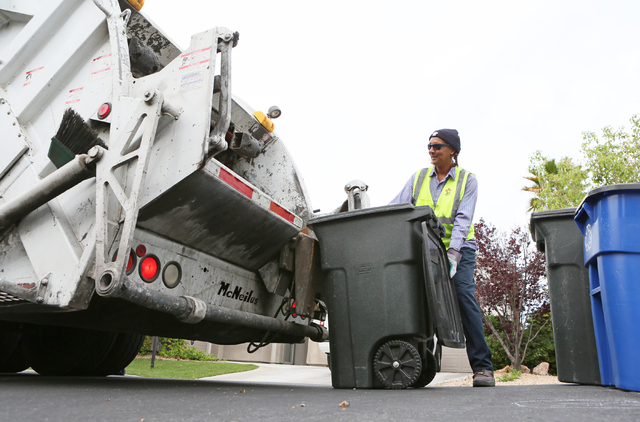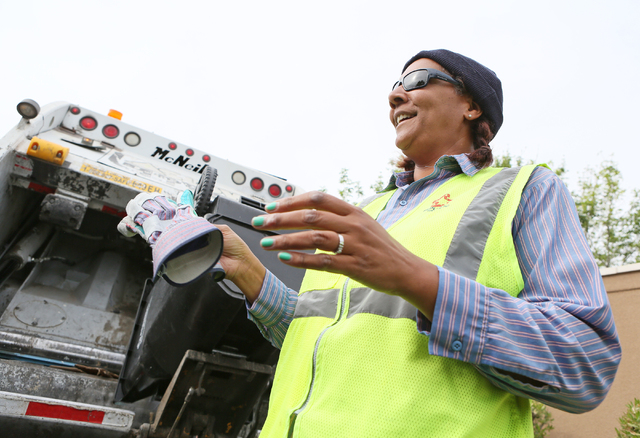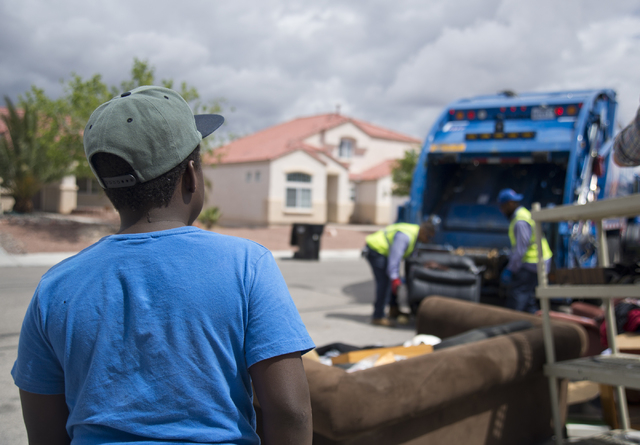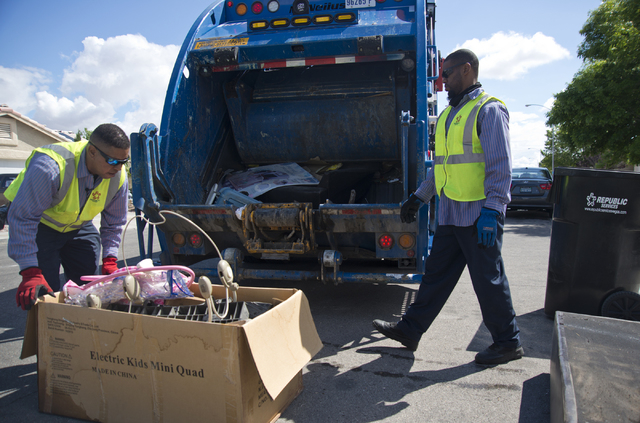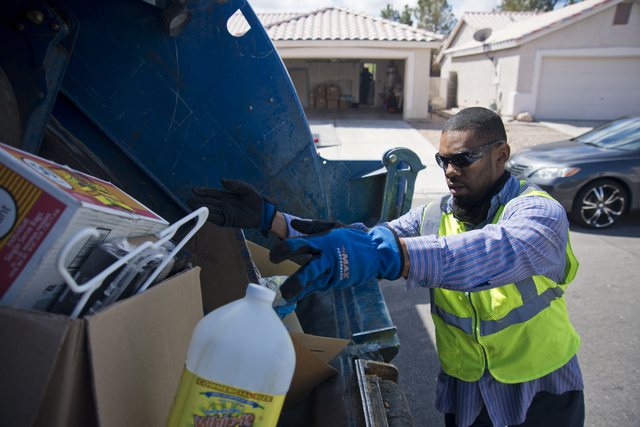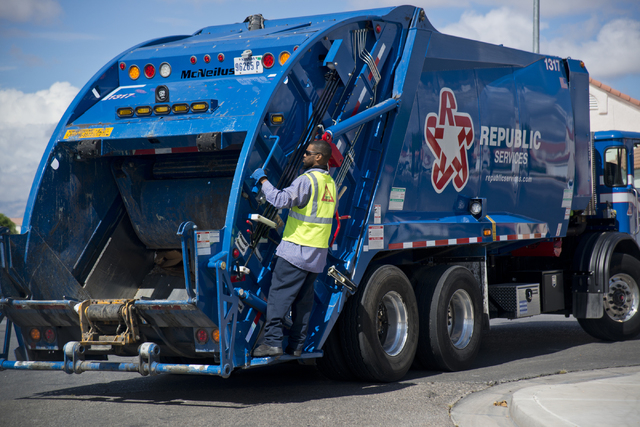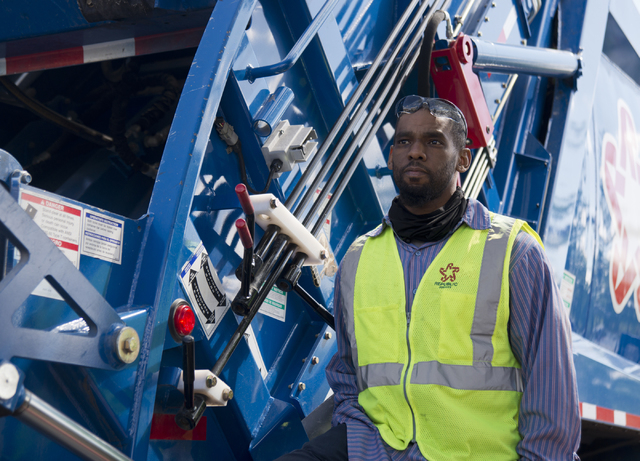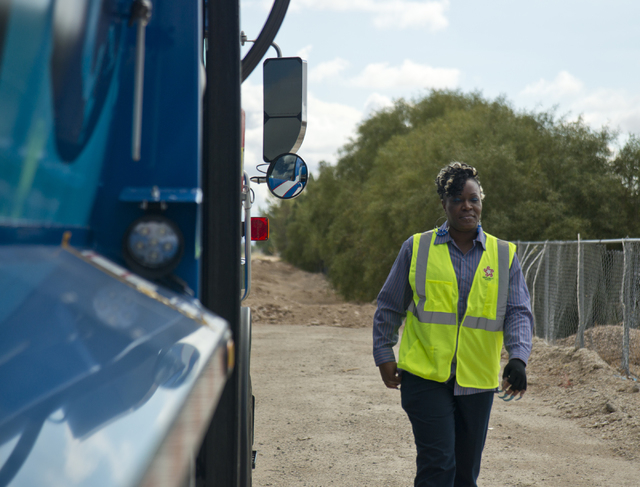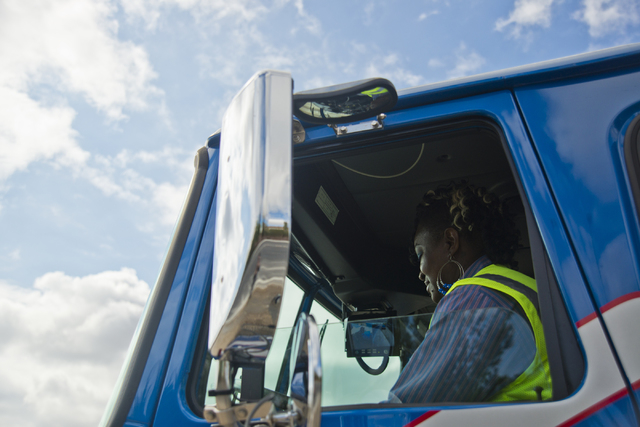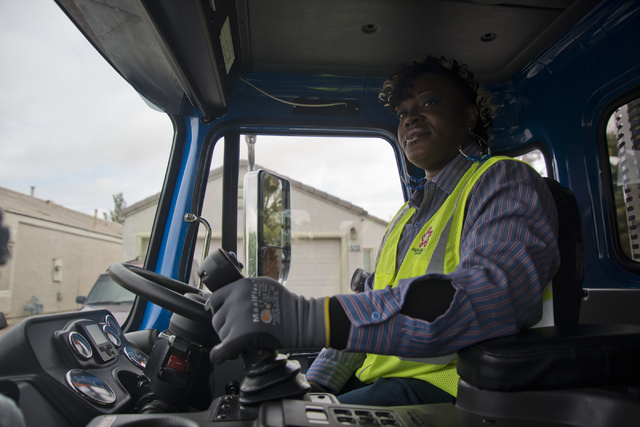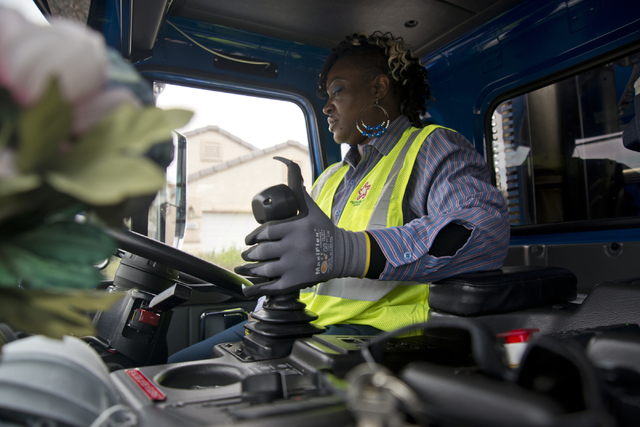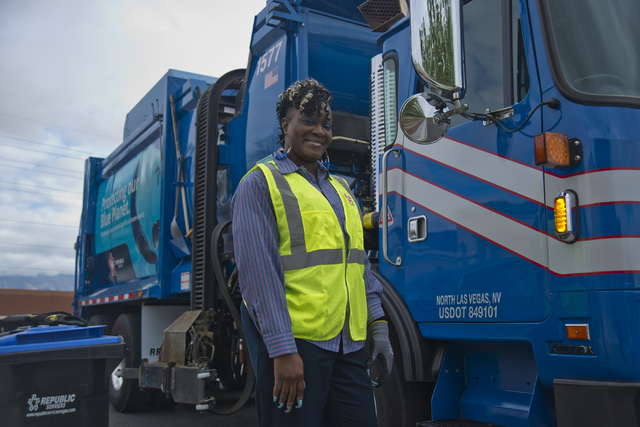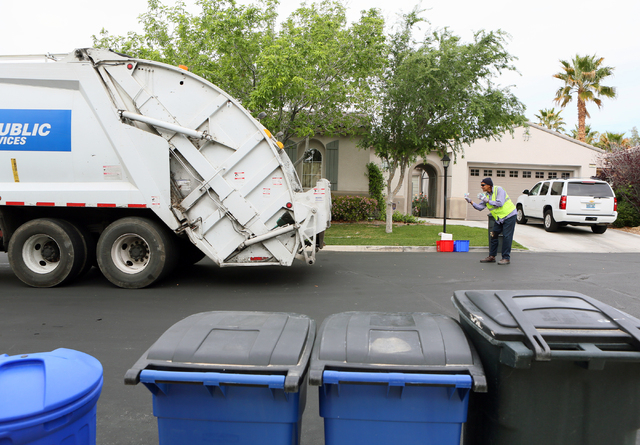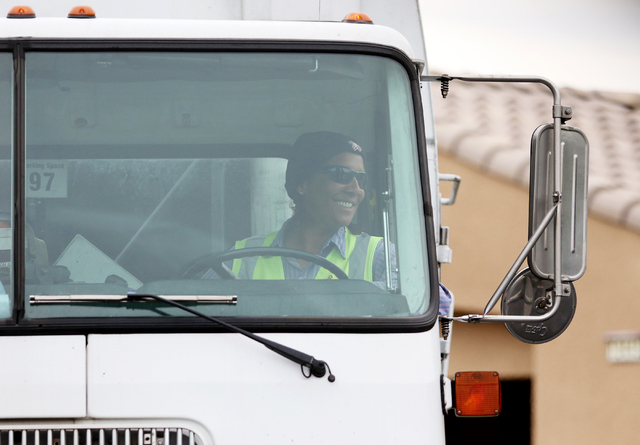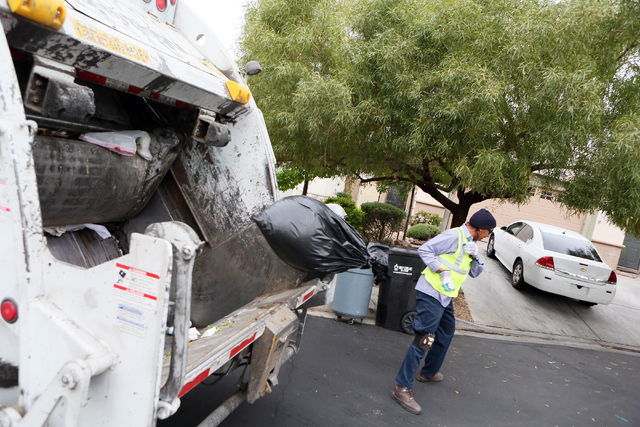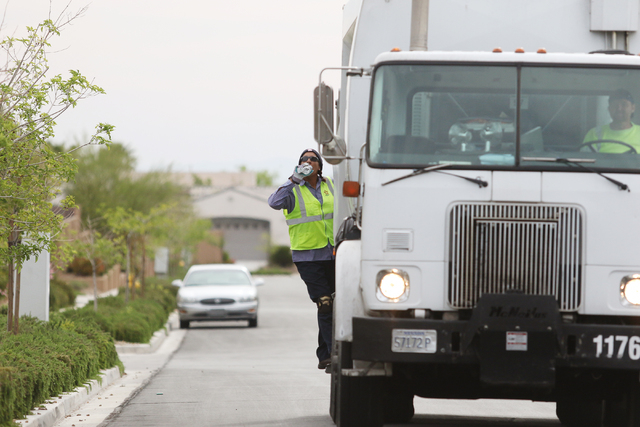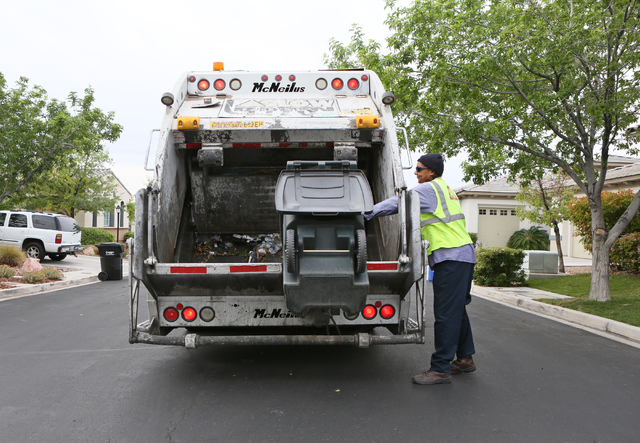These aren’t the garbage collectors you’re thinking of
Gina Givens, a breast cancer survivor, is one. So is Harry Mills, a college graduate, and Tim White, who is so active in his Shadow Hills Church that he invites strangers he’s barely met to pray with his congregation on Sundays.
Vicki Wright, who swims in her home’s backyard pool practically every day after a hard day’s work, is also one. Ditto for Jeff Hanson, a dedicated father of three girls who gets all the overtime he can to help his wife through nursing school.
They are Republic Service of Nevada sanitation workers, five of the 800 men and women who keep Las Vegas clean by picking up its garbage in 400 collection trucks. How they present themselves — well-spoken and professional — and the more than $60,000 a year they can earn for the strenuous and dangerous work they do is a far cry from the longtime stereotype of a garbage man: a boozing lawbreaker who lives on skid row and spends his money on rotgut wine.
“There’s been an unfair stigma associated with being a garbage man,” noted Mills as he drove a 32,000-pound collection truck through a North Las Vegas neighborhood. A former Las Vegas High School football star who went to Minot State University in North Dakota on an athletic scholarship, Mills believes people are seeing that the negative image of a garbage collector simply isn’t true. “You can’t do this job if you’re not in shape. I could have gone into corrections with my degree in criminology but I think this work is better for my family. Now more and more and more people want to do what I do.”
As another Earth Day rolled around Friday, a prominent academic scholar argues that what sanitation workers do for Las Vegas and the United States — keep it from becoming a public health nightmare — deserves to be in the spotlight.
“We should never, never take sanitation workers for granted,” said Robin Nagle, a New York University anthropologist who has studied waste management methods as well as sanitation workers. Her book, “Picking Up: On the Streets and Behind the Trucks with the Sanitation Workers of New York City,” was written to give readers a better sense of the people who are doing one of the nation’s most important jobs. “We have the luxury of not paying attention to what they do because they do it so well, despite it being one of the nation’s most dangerous jobs. We notice it when it’s not done.”
In her book, Nagle writes that in early America, the lack of garbage pickup had life and death consequences. She pointed out that an 1851 study found that a third of New York City’s deaths from diseases that year would have been prevented if basic sanitary measures had been followed.
“I take what we do very seriously,” 49-year-old Wright said recently after she stepped off the back of the truck she rode into a Summerlin neighborhood to empty a garbage bin. She threw a plastic bag in the back of the rumbling truck driven by her working partner of six years, Hanson, and then hurriedly climbed back aboard as Hanson took off again down the street. “It’s important, difficult and dangerous work but I’m not sure how many people understand that.”
For four 10-hour days a week, Hanson and Wright split the driving duties as they service about 1,500 houses each day, picking up a staggering 17 tons of stinking garbage daily, frequently in 100-degree-plus heat. With his wife in nursing school and three school-age children, Hanson says he works overtime all he can. The $45 an hour comes in handy.
Four years ago, Wright, who once managed Blockbuster video stores in Las Vegas, suffered a stress fracture in her foot as she collected heavy garbage. Today, she wears a knee brace on her left leg to keep it stable and a pad on her other kneecap for protection from repeated bumping against garbage bins.
It is not surprising to either Jim Rankin, a general manager for Republic, or Javon Jefferson, president of the Teamsters local, which negotiates employee contracts with Republic, that Wright or other sanitation workers suffer injuries. Rankin, while stressing that employees repeatedly undergo safety training, also says it is a strenuous job that is subject not only to lifting accidents but driving mishaps, as well, as trucks go in and out of traffic. Back injuries and hernias are common.
He said injuries occur at a frequency of about seven per 100 workers, with the company having about 80 workers’ compensation injuries per year. As Tim White took over driving duties from Mills in North Las Vegas, he recalled how a needle placed in a plastic garbage bag went completely through his finger when he picked it up.
“I had to get tested for HIV and other diseases for a year,” he said. He also had to have two surgeries for a torn rotator cuff in his shoulder. ‘That’s part of the reason I say a prayer every day before we start out,” he said. “You never know what’s going to happen.”
Nor, as White well knows from his needle stick, do you ever know what you’re going to pick up. On another occasion he found himself stopped by undercover police officers who told him not to place bags from one house into the truck. “They apparently had the place staked out for drugs,” he said. On other occasions, he’s found, after noting a particulary rancid smell, dead animals in bags. Then he called an animal control officer who got in touch with the homeowners.
When Wright and Hanson were loading a truck, they found a brand new revolver, which was turned over to Metro police. Mills loaded a porn collection that had been left out on the sidewalk for everyone to see. From time to time, sanitation workers receive radio messages from supervisors telling them not to pick up bags at a certain house. They learn that during a domestic dispute a spouse had thrown all the possessions of the significant other into the garbage.
Jefferson, a former sanitation worker, said overloaded garbage bins made it impossible for him to last past 11 a.m. on his first day on the job. He cramped so badly he couldn’t get comfortable sitting or standing. He could drink close to three gallons of water on a hot day. “I went from 265 to 205 pounds in a summer,” he said. “That’s how strenuous the work is.”
Sometimes injuries on the job are fatal. Two workers were killed near Mount Charleston in 1999 when the brakes failed on a 38,000-pound truck. In 2007, a worker slipped off a truck and was run over as the vehicle backed up. Workers have also been seriously injured when hit by cars passing too closely as they work. Sometimes tips of fingers are lost in the truck’s compactor or the compactors spew broken pieces of wood back in a worker’s face or body. Jefferson recalls a worker who was disabled after his foot was run over by a mammoth truck.
The federal Bureau of Labor Statistics routinely ranks sanitation worker as one of the top-10 most-dangerous occupations. The bureau reported in 2014 that the fatality rate of sanitation workers was the fifth most dangerous type of employment. Their 35.8 deaths per 100,000 workers comes in hehind roofers, aircraft pilots, fishermen and lumberjacks but more than two times as high a police patrolman. Included in the death rate for sanitation workers are deaths among recycling workers. In 2012 a line supervisor at a Republic recycling plant was crushed by a pile of paper 8 feet high.
While Wright doesn’t shy away from talking about the dangers of her job, she said that much of the danger can be mitigated by “maintaining your focus … you have to pick up things correctly and always concentrate on what you’re doing.”
On this day customers in the neighborhood near Garden Oaks Park bring Wright and Hanson, who recently won a community award for customer service, bottles of water and soda as well as a few doughnuts to eat.
After Wright, a California native, slips behind the wheel, she recalled that in high school, where her 6-foot-3-inch frame helped her become a star swimmer, she thought she’d either become a certified public accountant or police officer. But she became a military wife, had children early, and when she went to work, after a divorce, she went into retail. After running some Blockbuster video stores in Las Vegas, she found better money driving a cement truck and then in sanitation.
“I didn’t know whether I could handle this job at first,” she said. “I went home and cried my first few days. But finally my muscles got used to it and now I love it. I’m just glad my husband and I can afford a house with a pool so I can work out the aches and pains every day. Now I see women on my route and they yell out, ‘Girl power.’ It’s great.”
General manager Rankin said there are six other women who work in the same kind of lifting and driving capacity as Wright. About 15 other women, including Givens, drive an automated truck that has a mechanical arm that pops out of the top, swings down, hugs the garbage can and pulls it up and tips it into the waste collector.
As she picks up recyclables, she talks about the breast cancer she had four years ago. Just 33 years old, she opted to have both breasts removed and then reconstructive surgery. “I was so scared and so were my three kids,” she said. The removal of lymph nodes under her arm has caused her to have lymphadema, a chronic, painful swelling in her left arm caused by retention of lymph fluid. She must wear compression garments on her left hand and arm to hold down the swelling.
Unfortunately, the joystick used for the mechanical arm on her automated truck must be operated with her left hand. After a day of work, her arm often throbs. But she has a way of making herself feel better. She has cut the tips off both of her gloved hands so the two-and-a-half inch fingernails she has grown can be seen. To match her blue nails, she wears blue eye shadow. And she’s wearing a Mohawk hairstyle with blond streaks.
“I like to be feminine while I work,” she said, smiling. “It makes me feel good.”



